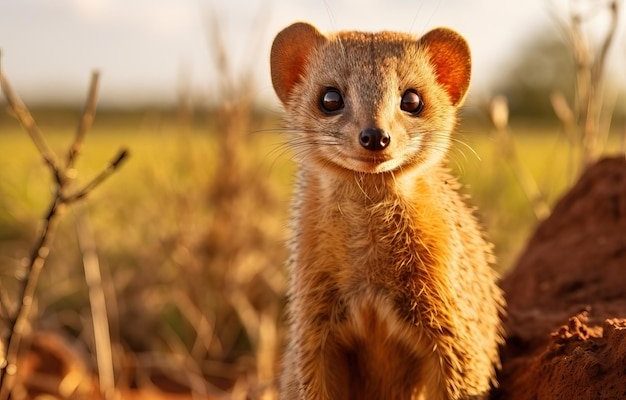
Mongooses belong to the family Herpestidae and are found in Africa, Asia, and even parts of Europe. They are known for their social behavior, agility, and, in some cases, their impressive ability to take on venomous snakes. So how exactly do they manage to not only survive but thrive in such harsh conditions? Let’s break it down.
Adaptations for Extreme Temperatures
Mongooses are true survivors, especially when it comes to temperature extremes. In deserts or arid regions, where the sun blazes down mercilessly, these animals have adapted in a few notable ways.
Firstly, their bodies are built for heat. Mongooses have a slim, elongated form, which helps them lose heat more effectively. This is somewhat similar to how a long drink of water can cool you down faster than a short one—it’s all about surface area. They tend to be active during the cooler parts of the day, such as early morning or late afternoon, to avoid the worst of the heat.
Secondly, mongooses have developed behaviors to keep cool. You might see them basking in the morning sun, warming up before retreating to shaded areas as the day heats up. Additionally, they often dig burrows or find small crevices to escape the scorching temperatures of midday. It’s all part of their strategic survival plan.
Finding and Storing Food
Food can be hard to come by in harsh environments, but mongooses are clever foragers. They have a varied diet that includes insects, small mammals, fruits, and even eggs.
Mongooses are known for their impressive hunting skills, often working in groups to tackle larger prey. Let me explain: when a group of mongooses spots a snake, for example, they’ll organize themselves strategically. One might distract the snake while others move in for the catch. This teamwork isn’t just effective; it’s a social bonding activity, strengthening their pack dynamics.
In addition to hunting, mongooses also have a knack for storing food. They will cache small amounts of food in hidden spots, ensuring they have something to nibble on later when a meal isn’t easy to find. This behavior is similar to how squirrels stash away nuts for the winter. Being resourceful is key in their harsh habitats.
Social Structures and Group Dynamics
Speaking of teamwork, mongooses typically live in groups called mobs or packs. This social structure plays a crucial role in their survival.
Living in a mob allows for shared responsibilities, especially when it comes to raising young and hunting. You might be wondering how this works: while some members go out to find food, others stay behind to watch over the young ones. This arrangement ensures that the next generation has the best chance at survival.
In these groups, mongooses also exhibit fascinating behaviors such as grooming and vocal communication. Grooming helps to strengthen social bonds while keeping their fur clean and free of parasites. Their vocalizations range from warning calls to playful chit-chat, creating a lively atmosphere even in the harshest environments. This sense of community is vital for their survival, allowing them to face challenges together.
Dealing with Predators
In the wild, threats are everywhere. Mongooses have a variety of methods for dealing with predators. First and foremost, their agility is incredible. With quick reflexes, they can dodge and weave away from danger, just like a seasoned athlete avoiding tackles.
But there’s more to their survival toolkit. Mongooses are known for their courage and aggressiveness when confronting threats. They can take on snakes, including venomous ones, showing off their impressive speed and dexterity. Some species have developed a resistance to certain snake venoms, allowing them to fight back rather than run away.
Additionally, they have an alertness that keeps them one step ahead. They’re constantly on the lookout, using their sharp eyesight and hearing to detect danger. When one member spots a potential threat, they communicate this information quickly, ensuring the whole pack can act in unison.
Water Conservation Techniques
In particularly dry habitats, mongooses have adapted clever strategies to conserve water. This adaptation is vital for survival where resources can be limited.
For instance, mongooses are efficient drinkers. They often get most of their moisture from the food they eat, especially if they consume insects and fruits, which have high water content. This is somewhat similar to how we can hydrate by eating juicy fruits when we’re thirsty.
When they do need to drink, mongooses have been known to be resourceful, sometimes digging in the ground to find moisture or visiting areas where dew collects. Their ability to make the most of what they have is a testament to their survival skills.
Camouflage and Defense Mechanisms
Let’s not forget about how mongooses utilize their surroundings for protection. Their fur coat often blends seamlessly into their environment, allowing them to stay hidden from predators. This camouflage is akin to how a chameleon adapts its colors; it’s all about survival.
In terms of defense, mongooses aren’t just relying on their speed and agility. Some species can emit a strong musk when threatened, deterring predators from attacking. This tactic is similar to how skunks ward off intruders with their smell.
Their ability to blend in with their surroundings, coupled with their defensive strategies, makes mongooses formidable survivors in an often unforgiving world.
So, there you have it! Mongooses are small but mighty creatures that showcase a variety of adaptations to survive in harsh environments. From temperature management to intricate social structures, they’ve found ways to thrive against the odds. Honestly, it’s quite inspiring how these little mammals navigate their challenges with such resilience.
Whether it’s their impressive hunting skills or clever water conservation techniques, mongooses remind us that resourcefulness and community play critical roles in survival. So, the next time you see one of these agile creatures, remember the incredible journey it has taken to thrive in its environment. They’re not just cute little animals; they’re survivors with a story worth knowing.

